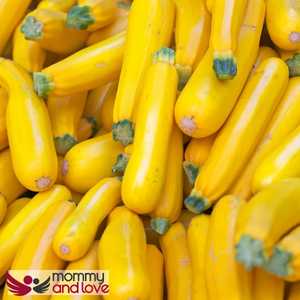Introducing solid foods to your baby is a huge milestone, and can be an exciting time for both parents and babies. There are many different ways to introduce solids, and one popular method is called baby-led weaning.
This approach allows little kids to feed themselves directly from family meals, which helps them learn about good nutrition and develop their motor skills. In this blog post, we will discuss the benefits of using yellow squash in baby-led weaning, as well as some recipes that you can try at home!
What Are the Health Benefits of Eating Yellow Squash?

Yellow squash is also known as summer squash. It is a healthy vegetable that provides many benefits to your health. It is high in vitamins A, B6, and C, folate, magnesium, fiber, riboflavin, phosphorus, manganese, and potassium.
These are some of the most essential vitamins, minerals, and nutrients for a baby’s growth and development.
What Is the Difference Between Butternut Squash and Yellow Squash?
Butternut squash is a winter squash, while yellow squash is a summer squash. Butternut squashes are larger and have thicker skin than summer squash. They also have a more intense flavor. Summer squash is softer and has a milder flavor.
It is also more watery than butternut squash. Both squashes are high in nutrients, but butternut squash has a higher vitamin A content.
When Can Babies Eat Yellow Squash?
Babies can start eating summer squash when they are about six months old when most of them start eating solids. Summer squash is a great source of vitamin A and C, as well as other nutrients that babies need for development.
It is important to make sure that the squash is cooked properly before giving it to your baby, as uncooked squash can contain harmful toxins.
Preparing your squash as finger food for self-feeding is important. They should be in the age-appropriate size to avoid choking hazard. You can cut them in half and into smaller pieces as your baby develops his pincer grasp.
When Can Babies Eat Butternut Squash?
Butternut squash is a winter squash, so it is best to wait until your baby is at least seven or eight months old before giving it to them. But generally, babies can start eating this nutritious vegetable at 6 months. Butternut squash is higher in vitamin A than yellow squash, so it is important to introduce it later on in the weaning process.
You can cook and serve them in a lot of ways – roasted, pureed, mashed and sauteed. But just like summer squash, it is important to cook butternut squash properly before giving it to your baby as baby food.
Can Babies Be Allergic to Yellow and Butternut Squash?
Squash in general is not a common allergen. Allergy to either yellow or butternut squash is extremely rare. There are only a couple of reports in the medical literature of babies being allergic to these vegetables.
If your baby has any kind of reaction after eating yellow or butternut squash, stop feeding them these vegetables and seek medical attention immediately especially if the reactions are severe.
Introducing a new food recipe can be tricky. You don’t want to overwhelm someone’s palate by giving them too much of the new food all at once.
Start by offering a small quantity of the new food, and wait a few days to see if there are any adverse reactions. If everything goes smoothly, gradually increase the quantity over the following meals.
Do You Have to Peel Yellow Squash Before Giving It to Your Baby?
The answer is no, you don’t have to peel summer squash before giving it to your baby. The soft flesh of the summer squash is a great source of dietary fiber, vitamin A, and vitamin C. It also contains important minerals like potassium and magnesium.
So feel free to give your baby summer squash without peeling it first. Just be sure to wash them well and remove the seeds before letting your baby eat them. Note that the rind might pose a choking risk.
How to Select and Store Yellow Squash for Baby Food
One of the best ways to make sure that your baby is getting all the nutrients they need is by feeding them homemade baby food. And one of the easiest vegetables to start with is yellow squash. It’s versatile, mild in flavor, and packed with nutrients like vitamin C and potassium.
When selecting a squash for making baby food, look for one that is firm and has smooth skin. Avoid any squashes that have any blemishes or soft spots. You can buy them at your local grocery store, Whole Foods and farmer’s market.
Put in an airtight container and store summer squashes in the fridge to keep them fresh. They will not last as long as their winter counterpart, so be sure to handle them gently when removing the seeds and do not damage the skin.
How To Cook Yellow Squash for Baby-Led Weaning
Before cooking your yellow squash for baby-led weaning, make sure to prepare them properly. One of the basics is cutting them in half and then into smaller pieces.
There are many ways to cook them so here are a few of our favorites:
- Cut the summer squash in half then slice it into small pieces. Put in a steamer basket and steam until tender.
- Sautee the summer squash in a little bit of oil until it is soft and tender.
- Bake the summer squash on a baking sheet lined with parchment paper in the oven at 375 degrees Fahrenheit until it is soft. You can also roast it along with some carrots and sweet potatoes.
- Puree the cooked squash in a food processor or blender until desired consistency. Squash puree is a fantastic first food because you can mix it with other foods such as pasta and risottos. You can also use add the puree to sauces.
Cooking yellow squash for your baby is a great way to introduce your child to this delicious vegetable. There are many baby food recipes out there, so be sure to experiment and find out which cooking method and recipe your child prefers.
How To Prepare Butternut Squash For Baby Led Weaning
Ingredients:
- One butternut squash, peeled, seeded and cubed
- One tablespoon of olive oil or butter
- Salt and pepper to taste (optional, you can remove the salt for younger babies)
Instructions:
Peel butternut squash for babies, remove the seeds and cut it in half lengthwise. Slice into cubes or bite-sized pieces. Preheat oven to 375 degrees F. In a sheet tray toss together butternut squash cubes, olive oil or butter, garlic powder and pepper. Spread squash cubes in a single layer on a baking sheet with parchment paper and bake for 25 minutes or until fork-tender, stirring once during baking.
Different Ways to Serve Butternut Squash to Babies

Butternut squash for babies can be served in so many different ways.
Some parents serve them mashed or mix them with formula or breast milk while others might roast them and give their baby a small butternut squash cube to eat and gnaw on.
Here are some other ideas:
- Butternut squash baby puree – Pureeing cooked butternut squash is a great way to get all the nutrients and fiber into your baby. Add a little bit of water, breastmilk, or formula to make the puree more liquid if needed.
- Butternut squash soup – A nice warm bowl of butternut squash soup is perfect for a cold winter day. You can mix it with other vegetables such as carrots and green beans. You can either make your own soup or buy a pre-made version. Just make sure to check the ingredients list for any hidden allergens.
- Seasoned Butternut squash – You can season your butternut squash with Italian seasoning, paprika and curry powder.
- Roasted – You can roast them along with other vegetables such as sweet potatoes.
- Butternut squash fries – Who doesn’t love french fries? These butternut squash fries are a healthier alternative and can be enjoyed by both babies and adults. Simply coat some sliced butternut squash in some olive oil, and pepper, then bake in the oven until crispy.
- Butternut squash pasta – This is a great dish to make when you have leftovers. Cook some whole wheat pasta shells and mix them with cooked butternut squash. You can also add some Parmesan cheese, puree or other herbs and spices for extra flavor.
No matter how you choose to serve butternut squash to your baby, they are sure to love it! It’s a great way to get them started on a healthy diet early on and there are more ideas on how to cook this wonderful vegetable.
Conclusion
Squash is a great vegetable to start introducing to your baby when you are doing baby-led weaning. It is versatile, easy to cook, and can be served in many different ways as finger foods or puree. It is not only good for babies, but for the whole family including older children. Be sure to try out some of our recipes and tips listed above. If you are looking for something more, there are more baby-friendly recipes out there!

This article was written by Sandra Baker – full time writer and the mother of four amazing kids (including twins!)
She’s also a breastfeeding counselor and has spent years helping new parents learn how to care for their children. When she’s not writing or caring for her children, Sandra likes to spend time reading and taking walks with her husband.




